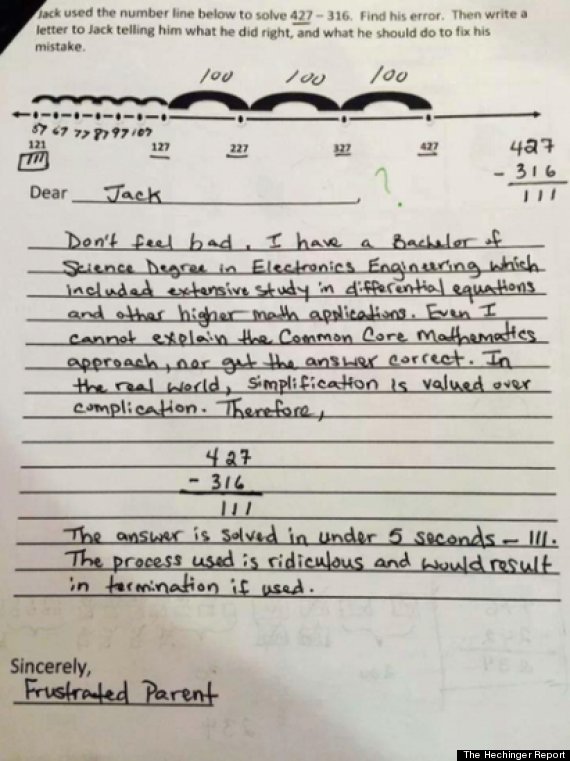When Jeff Severt went over his second grade son’s latest Math quiz, he was surprised to find a problem that even stumped him! Pictured below, “the problem takes a simple one-step subtraction problem and turns it into a complex endeavor with a series of unnecessary steps, including counting by 10s and 100s.”

Jeff Severt, who (as mentioned above) has a Bachelors of Science in Engineering, found the steps required for this simple subtraction problem overly complicated, especially for his son, who has autism, attention disorders and trouble with language arts.
Severt’s frustration aside, this question was actually specifically designed in such a “complicated” manner to meet several of the main Common Core math standards for second grade:
- Students should be able to bundle larger numbers into groups of 10s and 1s
ex: “100 can be thought of as a bundle of 10 tens – called a ‘hundred’.” - Students should be able to “add and subtract within 1000, by drawing or strategies based on place value bundling.”
- When adding / subtracting 3 Digit Numbers, students should add or subtract hundreds with hundreds, tens with tens, and ones with ones.
- When adding / subtracting 3 Digit Numbers, sometimes it is necessary to compose or decompose tens or hundreds
- Students can represent whole numbers on a number line.
- Students can represent whole-number sums and differences within 100 on a number line diagram
Though such language may seem “complicated,” the underlying goal is for students to understand and explain how they arrive at an answer (and not just memorize a formula). Such an understanding-based approach would allow students to tackle more difficult concepts and word problems with relative ease.
Granted, however, many Common Core experts agree, the Math problem Jeff Severt posted was not well designed. “The problem the question highlights is not an issue with the Common Core… but rather one of curriculum. Textbook publishers, smaller start-ups, school districts and teachers are all grappling with how best to incorporate the [new] standards into lesson plans, classroom activities, homework and quizzes that students encounter on a daily basis.”
In fact, many of the new materials labeled ‘Common Core’ may not even be well designed. As one Huffington Post Common Core expert, Jason Zimba explained, “the [Common core] standards allow a lot of freedom. People think the Common Core is a curriculum, and it’s not. The curriculum authors are going to interpret the standards in different ways.”
Confused by all these complicated requirements? Perplexed by the baffling realization that the label ‘Common Core’ does not necessitate that the material properly teaches basic Common Core requirements? Well, we don’t blame you!
Here at Genie Academy, it’s our job to sift through all the noise and ensure that we offer the most comprehensive curriculum, designed to ensure that your child will succeed at their school. Come try a free class, and see if Genie Academy can ease your Common Core frustrations.
(Jeff Severt, if you’re ever in New Jersey, do come stop by!)
To read more about the uproar this problem caused, read the full story on The Huffington Post.






